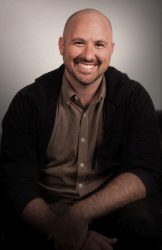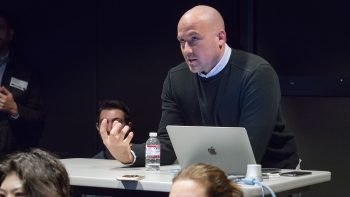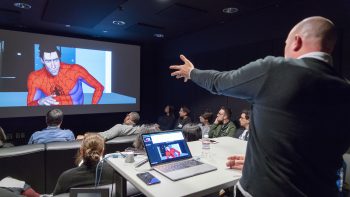Sony Animation is set to release the Academy Award winning Spider-Man: Into the Spider-Verse on digital February 26, 2019 and on blu ray March 19, 2019.
Last week our own Ashley Victoria Robinson was invited to the studio to interview many of the creative forces behind this major motion picture and some of the special features that will be appearing on the blu ray – including Joshua Beveridge, the Head of Character Animation on Spider-Man: Into the Spider-Verse.
JOSHUA BEVERIDGE: The biggest question we needed to address was “Why do we need another Spider-Man movie?” That was the first question. In my mind, I’m a fan, so the answer was, “Because it’s awesome.” but, everyone was asking the same thing over and over again and that’s something we had to answer, obviously.
movie?” That was the first question. In my mind, I’m a fan, so the answer was, “Because it’s awesome.” but, everyone was asking the same thing over and over again and that’s something we had to answer, obviously.
It’s a fair question because there had already been at least eight movies featuring Spider-Man in the last two decades and, so what made that question amazing is it put all of the leadership and the artists on the same exact page. That question – singularly – changed our workflow because instead of having to ask for permission for things, it was asked of us. Everyone, from the top down, knew it was obvious that we needed to be more than “just a little bit different”. We had to take a big, bold swing at what we were making.
Usually these things are so complex you only get to do one or two fresh new things. You are negotiating and budgeting and figuring out how to do this and this ask was, “How do we rethink absolutely everything?” and there wasn’t a clear goal of what to do. It was how much is possible to do?
So, we had a year to just try things and not think about efficiencies or how it’s going to scale or how we were going to do all of this – just what do we want? – and, then figure that out afterward, which is a wildly unique workflow.
The [point of view]we began with was start with what you know. We knew for a fact we’re making a comic book movie and we want our aesthetic to be the comic book itself. So, that was the anchor a lot of our decisions landed on and we made the decision that linework was important to us. Not every comic book has to have linework, but we chose that [as]important. We also wanted the world to feel printed and that seems like an aesthetic choice, but had a massive effect on the way we had to move characters and the way our cameras moved. That influenced our performance style a great deal.
And, we made a decision early on that we did not want to be nostalgic. We wanted to remind people of these two worlds we love and meld them together, but we needed to do it in a fresh, new, exciting way and, again, that’s another on that feels like it’s just a style thing, but it really effected how our performances were.
We gave ourselves two boundaries. I mean, we made a movie with a cartoon pig in it (laughs), but the middle of the road style – the Miles world, the base of the movie – we didn’t want to be called “a cartoon” and we didn’t want to be recreating reality. We wanted to pick and choose our favourite things from both of those worlds – because we love both of those worlds – but the base of our worlds need to live between that. And, there’s still a giant amount of space between those two things, so luckily Sony did this amazing thing where they hired some of the most amazing painters on the planet and they got together and made all of this amazing work and we started solidifying on a look and style and, this – we had something that was “Yes! This is cool!” We want to figure out how to make this move, how to make this a world we can live in.
So, we had these early concept paintings and we’ve all worked on projects where we have these paintings and they’re super, super cool and, then something changes when you start actually making it and that’s really where our workflow changed the most. That’s where we wanted to make sure that happened as little as possible.

Was Miles always going to be part of Spider-Verse?
JB: Absolutely. Yes. At least as far as I was aware. (laughs)
[When we did character tests] this was when we made the decision to start animating on twos. Animating on twos does some really neat things. For me, I love the texture of it. It feels a little bit more “pop art crisp”. You get a little bit more clarity and it pulls the needle a little bit more toward that base reality.
… we landed, this was our answer: cameras nice and smooth [on]ones and [animation]on twos, but it’s as if I only have twelve drawings and in between each drawing just sliding a little bit. That gives you that bite.
Now we know where the needle has to be placed and we can start applying that to our suite of main characters.You always want to give yourself a little more time with your mains, to find them.
There’s another theory that we learned when we were going through them. When there’s a big area of the surface that would normally be round [i.e. the top of bald head] – because we wanted to not have any gentle gradients or softness – making that a strong decision change, a plain or break that just cuts edge to edge, did two beautiful things. One, it gives lighting this nice anchor … to make a colour choice, but it also gives the animation team a canvas – a blank canvas – where we could choose when and where to put linework. And, had more freedom. They’re not just anchored into modeled-in wrinkles. You have spaces where you can choose what expression or clarify with that.
… Once we learned that Miles was going to be an artist that allowed the whole team access to his thought process. He’s going to be a little bit more introverted. That gives us a little bit more likeable reason for him to be rebellious in a beautiful way.
… But what about when they’re Spider-Men? How different are they going to be when they’re swinging through the city? Peter’s more the veteran. He has to warm up and stretch. He can still hit those iconic poses – he’s got the muscle memory – but it takes more work and, then Miles, as the younger one, he’s more exuberant and playful. He’s wasteful in his energy. It’s fun. But, they both need to still be Spider-Men and what that is, is a low center of gravity and long limbs. So, not matter which character it is – so long as we’re arching the spine in that way, keeping the chest and pelvis in that relationship, the limbs outstretched – we can invent new iconic poses for them in character.
In animation we did the emotional lines – the acting lines – for expressions and we found it’s going to be hard to ever animate without them. They’re so powerful. It looks more on model. Just the little indent of an eye or a dimple totally change how you feel about the same expression and without them it didn’t feel on-model. Every animator had the ability to pose, move them around wherever they liked, whenever they liked so long as it was in character and on model.
We also did action lines. There was a huge appetites for doing those special one-offs for performances, but I wanted to keep the animation team doing those things that were special one-offs as much as possible. The effects team did this amazing thing where any linework that we could find rules for – rules such as: for the jaw or the nose, for instance, where its based on iconography from head-angle-to-camera relationship – now we can define a library of drawings so that’s what it would always be. They can feed that into a machine learning program [so, then] the computer is guessing what goes on what frame and when it’s wrong someone adjusts it and makes a new rule and little-by-little we’re teaching the computer to draw things that we find redundant and, therefore, the team can be spending more time working on creative [aspects].
… A lot of people would think because we’re animating on twos we’re doing half the frames and half the work – nothing could be further from the truth. We’re just prioritizing different things. We’re designing more and working more – making more decisions. But, additionally, we also have to work so cleanly that when we have to give the animation over to the cloth and hair and teams that need simulations a second file can be written out that’s automatically splined, so they have all the data they need to do their simulations.
… There’s also this moral of the movie that “Anybody can wear the mask.” and anyone can imagine themselves being Spider-Man because his entire body’s covered up in this suit. In animation I have another interpretation. Because animators have this special role where we can pretend to be absolutely anything. You can be a doorknob, a fish. We all were Spider-Man throughout this movie and we encouraged everyone to work the best way that works for them. Some people talk through their ideas, some people do this “energy pass” where they’re blocking primitive shapes through the space so they have that idea, some people thumbnail and really blueprint everything, and some people run around the office pretending to be the characters in the movie.

When you are dealing with a character like Peter Parker, who we see two versions of, how do you address making them distinct beyond the Ben Reilly hair colour?
JB: Oh, it’s all about where they’re at in their life. So, the Chris Pine version of Spider-Man, he’s the perfect pristine version of Spider-Man that can do no wrong and would be the best role model if he had lived a little longer (laughs) and he seems like he has everything in control. Life went well for him, so it’s even more confident. We just played him as perfect as could to make it as heartbreaking as possible, honestly. And, then, I think a lot of us – myself in particular – could really relate to the other one and he was easy to access. He’s comfortable, but had a little bit more drama in his life and you play that with ware. We literally used the same character, but we just treated and posed him differently. We gave him a little bit of a broken nose and a little bit more distressed lines, but we got to have the same character – on our side – play both roles. It was all in acting.

Can you talk a little bit about creating the very manga/anime-inspired version of Peni Parker?
JB: I’m really proud of how she turned out because she was a pretty big engineering feat because her face had to be so pliable and just feel like drawings. We did a really deconstructed version of her. It’s scary what she looks like when she’s not rendered! It’s very cool when it came out and we changed the way we were performing her depending on the scene. She’s one of the characters who is, more often than not, animated on threes throughout the movie than even twos. It’s more limited in the dialogue performances, but when it came to action we can go to the tenth and I think most of the animators that did the action scenes needed to be anime fans, themselves, to really know what the goal was to begin with.
It’s hard to explain what really went into her rig that made her different, but we built her differently than everyone else, so there’s no chance of her being the same as anyone else.

When you have all these characters representing different animation styles in the ame movie together are those scenes that much more difficult than any other scene?
JB: The adjective we were chasing with everyone, no matter what their design was was “cool”. What’s the coolest thing that the cartoon pig version of this would be? What’s the coolest thing that anime Peni would be? And that made them all familiar. That put them in the same taste aesthetic, even though they look like they’re from different taste aesthetics.
And, then a lot of that, honestly, goes down to casting. Some animators just really shine at Spider-Ham’s animation. Some people you had to be more particular with who handled those ones.
There are some very direct stylistic references to specific comic book artists – can you talk about that decision making process and how you arrived at some of those choices?
JB: Yeah. They’re the inspiration. We wanted to pick and choose our favourite elements of some of our favourite comic books and comic book artists and marry them across. We did look at those as inspiration for how we carried on. Kingpin, in particular, he’s another one where in animation he was an engineering feat because we wanted him to be such a graphic shape and how to get him to feel like he’s capable, but so big, also could feel comfortable. He has almost a Jekyll-and-Hyde part of his personality – because he does as a character – but on animation he’s sculpted to every frame. He’s another one where, if the camera is on the other side of him, he looks like a joke (laughs). It doesn’t work. He loses all his power, but when he’s absorbing the entire frame? It’s a beautiful statement. It’s graphic. We’re looking to our favourite graphic designers and artists as influence for how we’re going to make the movie.



